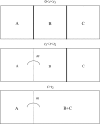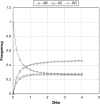Subdivision in an ancestral species creates asymmetry in gene trees
- PMID: 18689871
- PMCID: PMC2734134
- DOI: 10.1093/molbev/msn172
Subdivision in an ancestral species creates asymmetry in gene trees
Abstract
We consider gene trees in three species for which the species tree is known. We show that population subdivision in ancestral species can lead to asymmetry in the frequencies of the two gene trees not concordant with the species tree and, if subdivision is extreme, cause the one of the nonconcordant gene trees to be more probable than the concordant gene tree. Although published data for the human-chimp-gorilla clade and for three species of Drosophila show asymmetry consistent with our model, sequencing error could also account for observed patterns. We show that substantial levels of persistent ancestral subdivision are needed to account for the observed levels of asymmetry found in these two studies.
Figures




Similar articles
-
Likelihood and Bayes estimation of ancestral population sizes in hominoids using data from multiple loci.Genetics. 2002 Dec;162(4):1811-23. doi: 10.1093/genetics/162.4.1811. Genetics. 2002. PMID: 12524351 Free PMC article.
-
On the Number of Non-equivalent Ancestral Configurations for Matching Gene Trees and Species Trees.Bull Math Biol. 2019 Feb;81(2):384-407. doi: 10.1007/s11538-017-0342-x. Epub 2017 Sep 14. Bull Math Biol. 2019. PMID: 28913585 Free PMC article.
-
Probability distribution of molecular evolutionary trees: a new method of phylogenetic inference.J Mol Evol. 1996 Sep;43(3):304-11. doi: 10.1007/BF02338839. J Mol Evol. 1996. PMID: 8703097
-
[Molecular phylogeny of humans, chimpanzees and gorillas].Tanpakushitsu Kakusan Koso. 2000 Dec;45(16):2588-95. Tanpakushitsu Kakusan Koso. 2000. PMID: 11185912 Review. Japanese. No abstract available.
-
Evolutionary biology: how did the human species form?Curr Biol. 2006 Aug 22;16(16):R647-50. doi: 10.1016/j.cub.2006.07.032. Curr Biol. 2006. PMID: 16920616 Review.
Cited by
-
Recombinational landscape and population genomics of Caenorhabditis elegans.PLoS Genet. 2009 Mar;5(3):e1000419. doi: 10.1371/journal.pgen.1000419. Epub 2009 Mar 13. PLoS Genet. 2009. PMID: 19283065 Free PMC article.
-
Multispecies coalescent and its applications to infer species phylogenies and cross-species gene flow.Natl Sci Rev. 2021 Jul 15;8(12):nwab127. doi: 10.1093/nsr/nwab127. eCollection 2021 Dec. Natl Sci Rev. 2021. PMID: 34987842 Free PMC article.
-
A Tale of Too Many Trees: A Conundrum for Phylogenetic Regression.Mol Biol Evol. 2025 Mar 5;42(3):msaf032. doi: 10.1093/molbev/msaf032. Mol Biol Evol. 2025. PMID: 39930867 Free PMC article.
-
The date of interbreeding between Neandertals and modern humans.PLoS Genet. 2012;8(10):e1002947. doi: 10.1371/journal.pgen.1002947. Epub 2012 Oct 4. PLoS Genet. 2012. PMID: 23055938 Free PMC article.
-
Phylogenomic analysis does not support a classic but controversial hypothesis of progenitor-derivative origins for the serpentine endemic Clarkia franciscana.Evolution. 2022 Jun;76(6):1246-1259. doi: 10.1111/evo.14484. Epub 2022 Apr 20. Evolution. 2022. PMID: 35403214 Free PMC article.
References
-
- Aquadro CF, DuMont VB, Reed FA. Genome-wide variation in the human and fruitfly: a comparison. Curr Opin Genet Dev. 2001;11:627–634. - PubMed
-
- Hudson RR. Testing the constant-rate neutral allele model with protein sequence data. Evolution. 1983;37:203–217. - PubMed
-
- Hudson RR. Generating samples under a Wright-Fisher neutral model of genetic variation. Bioinformatics. 2002;18:337–338. - PubMed
Publication types
MeSH terms
Grants and funding
LinkOut - more resources
Full Text Sources
Molecular Biology Databases

